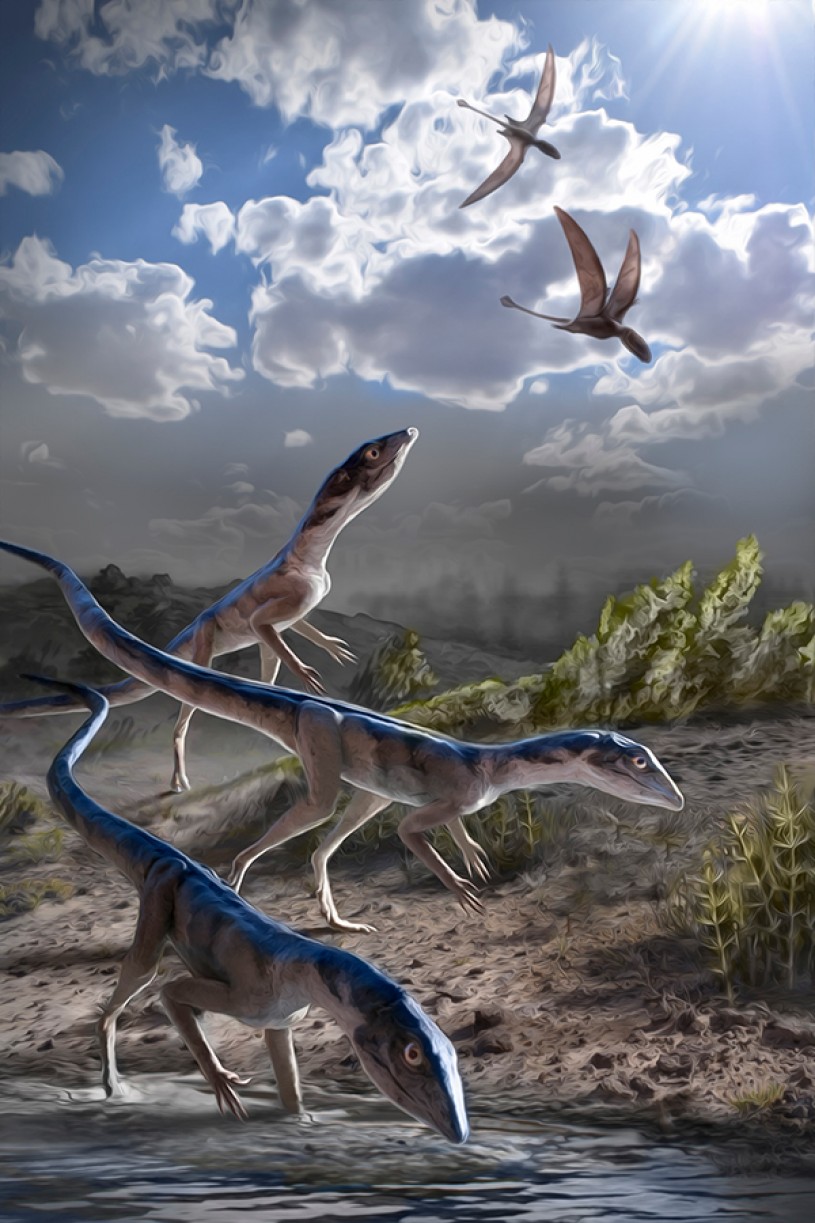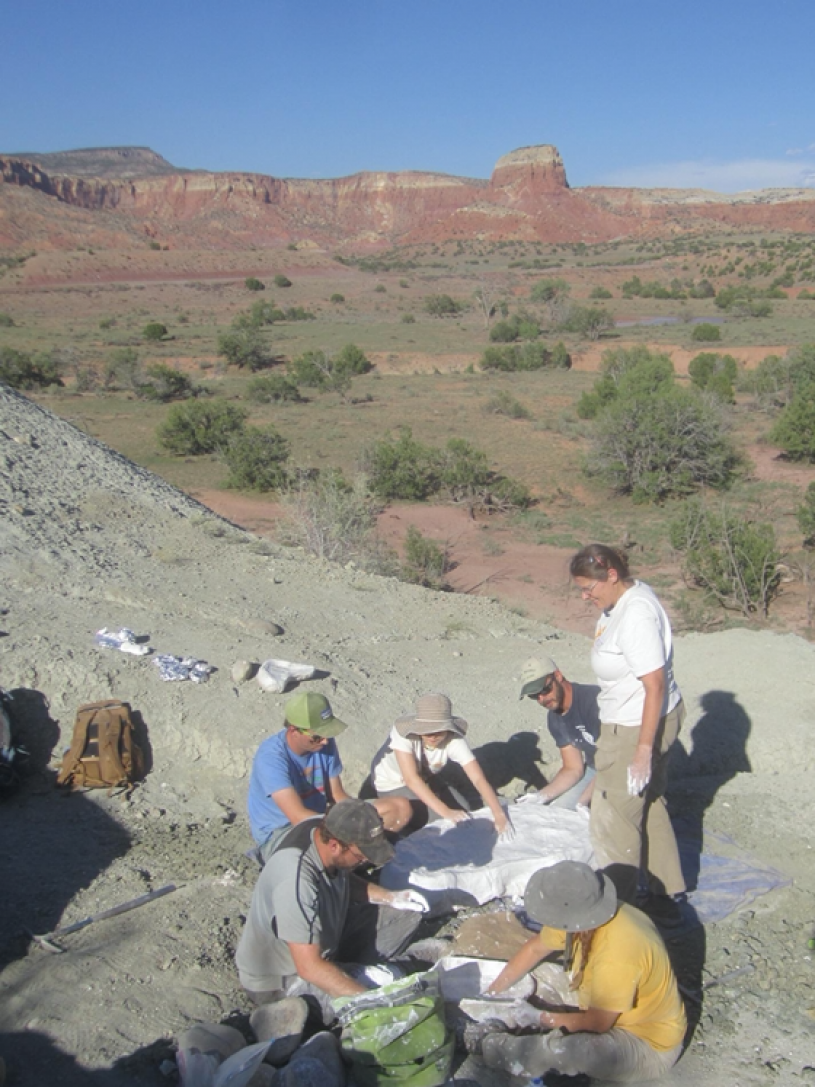December 9, 2020 (Los Angeles, CA)—Flying reptiles called ‘pterosaurs’ flew over the heads of dinosaurs for more than 150 million years. These remarkable animals evolved a myriad of shapes and sizes—some even larger than a small plane—becoming the first vertebrates (back-boned animals) to take to the air. However, the specifics of how these unique animals accomplished this feat, and from where they evolved, has remained a mystery. In a paper published today in Nature, Natural History Museums of Los Angeles County (NHMLAC) scientist Dr. Nathan Smith, Associate Curator in the Dinosaur Institute, and an international team of scientists have cracked one of the great paleontological mysteries: the origin and early evolution of pterosaurs, a topic of great scientific interest since the discovery of the first pterosaur fossils in the second half of the 1700s.
“‘Where did pterosaurs come from?’ is one of the most outstanding questions in reptile evolution; we think we now have an answer,” says co-author Dr. Sterling J. Nesbitt of Virginia Tech. The authors introduce strong evidence that the closest relatives of pterosaurs are a poorly known group of ‘dinosaur precursors’ called lagerpetids, which lived across the ancient supercontinent Pangea during much of the Triassic Period, from about 237 to 210 million years ago. Lagerpetid skeletal parts, including skulls, forelimbs, vertebrae, have been found in Brazil, Argentina, Madagascar and the United States, with key fossils utilized in the study coming from a collaborative field project in Ghost Ranch, New Mexico, involving NHMLAC’s Dinosaur Institute.
“Late Triassic fossils have been collected from Ghost Ranch for over 100 years,” says co-author Dr. Nathan Smith of NHMLAC, “but more recently, discoveries of lagerpetids like Dromomeron and early dinosaurs such as Tawa have ignited a mini-renaissance in our understanding of dinosaur and pterosaur origins and early evolution.”
Previously known mostly from hip and hindlimb bones, these newly discovered lagerpetid skull and forelimb specimens were examined with new technological advances, such as micro Computed Tomography [µCT] scanning. The resulting reconstruction shows that the brains and inner ears of pterosaurs and lagerpetids are similar, suggesting that some of the specialization in pterosaur sensory systems evolved prior to flight. “This study is a result of an international effort applying both traditional and cutting-edge techniques. This is an example of how modern science can shed light on long standing questions that haunted paleontologists during more than a century,” says lead author Dr. Martín D. Ezcurra of Museo Argentino de Ciencias Naturales, Buenos Aires, Argentina.
“When I first saw a lower jaw with tricuspid teeth preserved alongside fossils of dinosaurs and the Brazilian lagerpetid Ixalerpeton, I thought that we had discovered the oldest pterosaur. Later, other lagerpetids with ‘pterosaur traits’ started appearing in the US, Madagascar, and Argentina, revealing the close relation between these two groups. In the end, the jaw belonged to Ixalerpeton itself, and helped us unveil the origins of the flying reptiles,” says co-author Dr. Max C. Langer of Universidade de São Paulo, Ribeirão Preto, Brazil. The newly discovered evolutionary relationships create a new paradigm for understanding the origin of pterosaurs, and provide a completely new framework for the study of the origin of these animals and their flight capabilities.
“These new discoveries and insights into lagerpetid anatomy have given us a bit of an ‘evolutionary roadmap’ for understanding where pterosaurs came from,” says Dr. Nathan Smith. “It’s a great example of how international and multidisciplinary collaboration can create paradigm shifts in paleontology. And while these new fossils help close the gap on pterosaur origins, it’s clear that there are more discoveries waiting to be made in the Triassic that will continue to shed light on these incredible animals.”
NHMLAC Dinosaur Institute's Field Project at Ghost Ranch, New Mexico
Made famous by Georgia O’Keefe’s dramatic paintings of its colorful badlands, Ghost Ranch hosts a multi-year, ongoing excavation project co-led by Dr. Nathan Smith, Associate Curator at NHMLAC’s Dinosaur Institute, to collect Late Triassic dinosaurs from the Hayden Quarry. The Dinosaur Institute (DI) houses the museum's collection of Mesozoic tetrapods (four-limbed vertebrates), dating from 250 million years ago to 65.5 million years ago. This collection includes fossils of dinosaurs spanning the Mesozoic Era, as well as fossils of other tetrapods that lived alongside the dinosaurs, such as flying and marine reptiles, crocodiles, turtles, amphibians, and early mammals. Over the years, NHMLAC crews and colleagues have collected more than 25,000 specimens from two dozen different species of animals at Ghost Ranch, including new species of dinosaur and dinosaur relatives such as Dromomeron. Fieldwork was conducted with the permission and support of the Ghost Ranch Conference Center, and fossils collected from Ghost Ranch are curated in the Ghost Ranch Ruth Hall Museum of Paleontology. Dr. Smith’s and colleagues’ research at Ghost Ranch has been supported by the National Science Foundation and the National Geographic Society. Learn more about NHMLAC’s fieldwork and the Dinosaur Institute here.
Reference: Martín D. Ezcurra 1,2, Sterling J. Nesbitt 3, Mario Bronzati 4, Fabio M. Dalla Vecchia 5,6, Federico L. Agnolin 7,8, Roger B. J. Benson 9, Federico Brissón Egli 7, Sergio F. Cabreira 14, Serjoscha W. Evers 9,10, Adriel R. Gentil 7, Randall B. Irmis11, Agustín G. Martinelli 1, Fernando E. Novas 7, Lúcio Roberto da Silva 14, Nathan D. Smith 12, Michelle, R. Stocker 3, Alan H. Turner 13 & Max C. Langer4 (2020) Enigmatic dinosaur precursors bridge the gap to the origin of Pterosauria, Nature, DOI: 10.1038/s41586-020-3011-4
The authors of this article are affiliated with: 1 Sección Paleontología de Vertebrados CONICET−Museo Argentino de Ciencias Naturales “Bernardino Rivadavia”, Avenida Ángel Gallardo 470, Buenos Aires, Argentina; 2 School of Geography, Earth and Environmental Sciences, University of Birmingham, Edgbaston, Birmingham, U.K.; 3 Department of Geosciences, Virginia Tech, Blacksburg, Virginia, U.S.A.; 4 Departamento de Biologia, Universidade de São Paulo, Avenida Bandeirantes 3900, Ribeirão Preto, Brazil; 5 Research Group of Mesozoic Faunas, Institut Català de Paleontologia Miquel Crusafont (ICP), Carrer de l'Escola Industrial 23, Sabadell, Catalonia, Spain; 6 Museo Friulano di Storia Naturale, Via Sabbadini 22-34, Udine, Italy; 7 Laboratorio de Anatomía Comparada y Evolución de los Vertebrados CONICET−Museo Argentino de Ciencias Naturales “Bernardino Rivadavia”, Avenida; Ángel Gallardo 470, Buenos Aires, Argentina; 8 Fundación de Historia Natural ‘Félix de Azara’, Departamento de Ciencias Naturales y Antropología, Universidad Maimónides, Hidalgo 775, Buenos Aires, Argentina; 9 Department of Earth Sciences, University of Oxford, South Parks Road, Oxford, U.K.; Av. Antônio Bozzetto, 305, Faxinal do Soturno, Brazil; 10 Department of Geosciences, University of Fribourg, Chemin du Musée, Fribourg, Switzerland; 11 Natural History Museum of Utah and Department of Geology & Geophysics, University of Utah, Salt Lake City, UT, USA; 12 The Dinosaur Institute, Natural History Museum of Los Angeles County, Los Angeles, CA, USA; 12 Department of Anatomical Sciences, Stony Brook University, Stony Brook, NY, USA; 14 Unaffiliated: Sergio F. Cabreira, Lúcio Roberto da Silva. ✉e-mail: martindezcurra@yahoo.com.ar
For a copy of the article published in Nature and imagery, please contact Sally Márquez, smarquez@nhm.org.
About the Natural History Museums of Los Angeles County
The Natural History Museums of Los Angeles County (NHMLAC) include the Natural History Museum in Exposition Park, La Brea Tar Pits in Hancock Park, and the William S. Hart Museum in Newhall. They operate under the collective vision to inspire wonder, discovery, and responsibility for our natural and cultural worlds. The museums hold one of the world’s most extensive and valuable collections of natural and cultural history—more than 35 million objects. Using these collections for groundbreaking scientific and historical research, the museums also incorporate them into on- and offsite nature and culture exploration in L.A. neighborhoods, and a slate of community science programs—creating indoor-outdoor visitor experiences that explore the past, present, and future. Visit NHMLAC.ORG for adventure, education, and entertainment opportunities.
MEDIA CONTACT
Sally Márquez
NHMLAC
smarquez@nhm.org
213.373.3217

